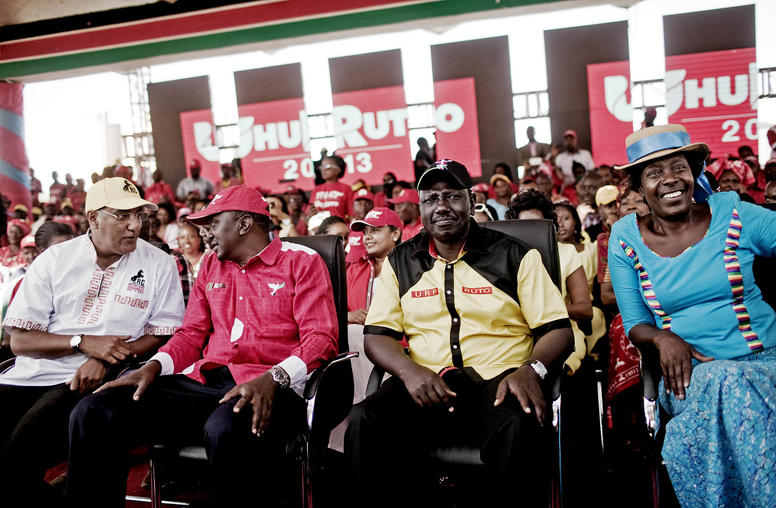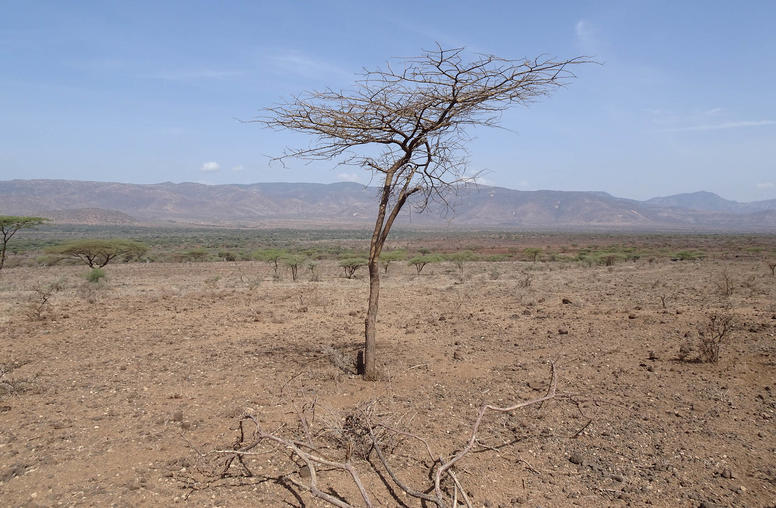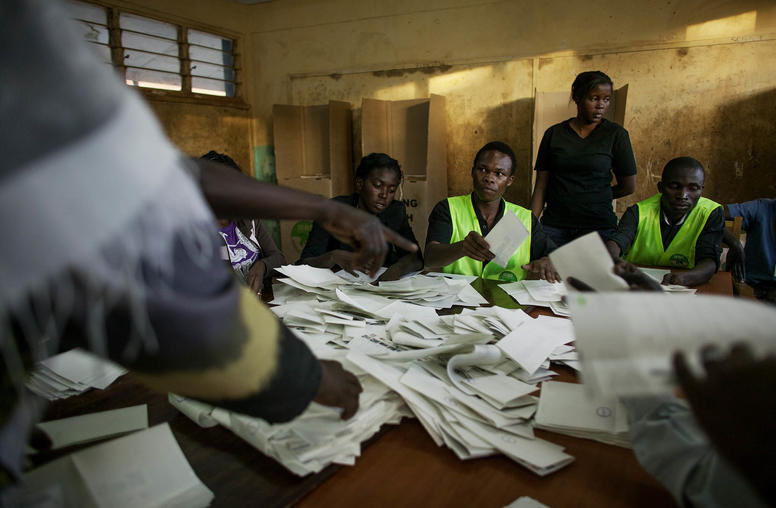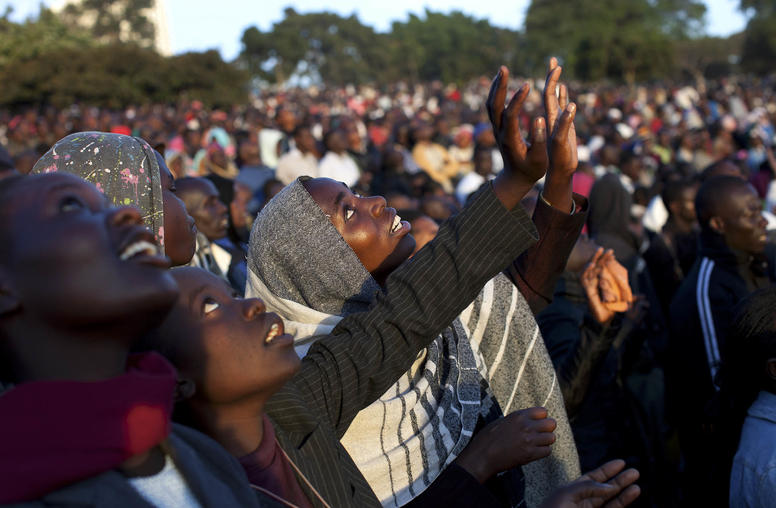Can Big Data Stop Wars Before They Happen?
Number crunching and pattern recognition may hold the key to predicting and preventing conflicts. But first, peace-builders need to change the way they do business.
It has been almost two decades exactly since conflict prevention shot to the top of the peace-building agenda, as large-scale killings shifted from interstate wars to intrastate and intergroup conflicts.

What could we have done to anticipate and prevent the 100 days of genocidal killing in Rwanda that began in April 1994 or the massacre of thousands of Bosnian Muslims at Srebrenica just over a year later? The international community recognized that conflict prevention could no longer be limited to diplomatic and military initiatives, but that it also requires earlier intervention to address the causes of violence between nonstate actors, including tribal, religious, economic, and resource-based tensions.
For years, even as it was pursued as doggedly as personnel and funding allowed, early intervention remained elusive, a kind of Holy Grail for peace-builders. This might finally be changing. The rise of data on social dynamics and what people think and feel -- obtained through social media, SMS questionnaires, increasingly comprehensive satellite information, news-scraping apps, and more -- has given the peace-building field hope of harnessing a new vision of the world. But to cash in on that hope, we first need to figure out how to understand all the numbers and charts and figures now available to us. Only then can we expect to predict and prevent events like the recent massacres in South Sudan or the ongoing violence in the Central African Republic.
A growing number of initiatives have tried to make it across the bridge between data and understanding. They've ranged from small nonprofit shops of a few people to massive government-funded institutions, and they've been moving forward in fits and starts. Few of these initiatives have been successful in documenting incidents of violence actually averted or stopped. Sometimes that's simply because violence or absence of it isn't verifiable. The growing literature on big data and conflict prevention today is replete with caveats about "overpromising and underdelivering" and the persistent gap between early warning and early action. In the case of the Conflict Early Warning and Response Mechanism (CEWARN) system in central Africa -- one of the earlier and most prominent attempts at early intervention -- it is widely accepted that the project largely failed to use the data it retrieved for effective conflict management. It relied heavily on technology to produce large databases, while lacking the personnel to effectively analyze them or take meaningful early action.
To be sure, disappointments are to be expected when breaking new ground. But they don't have to continue forever. This pioneering work demands not just data and technology expertise. Also critical is cross-discipline collaboration between the data experts and the conflict experts, who know intimately the social, political, and geographic terrain of different locations. What was once a clash of cultures over the value and meaning of metrics when it comes to complex human dynamics needs to morph into collaboration. This is still pretty rare, but if the past decade's innovations are any prologue, we are hopefully headed in the right direction.
* * *
Over the last three years, the U.S. Defense Department, the United Nations, and the CIA have all launched programs to parse the masses of public data now available, scraping and analyzing details from social media, blogs, market data, and myriad other sources to achieve variations of the same goal: anticipating when and where conflict might arise. The Defense Department's Information Volume and Velocity program is designed to use "pattern recognition to detect trends in a sea of unstructured data" that would point to growing instability. The U.N.'s Global Pulse initiative's stated goal is to track "human well-being and emerging vulnerabilities in real-time, in order to better protect populations from shocks." The Open Source Indicators program at the CIA's Intelligence Advanced Research Projects Activity aims to anticipate "political crises, disease outbreaks, economic instability, resource shortages, and natural disasters." Each looks to the growing stream of public data to detect significant population-level changes.
Large institutions with deep pockets have always been at the forefront of efforts in the international security field to design systems for improving data-driven decision-making. They've followed the lead of large private-sector organizations where data and analytics rose to the top of the corporate agenda. (In that sector, the data revolution is promising "to transform the way many companies do business, delivering performance improvements not seen since the redesign of core processes in the 1990s," as David Court, a director at consulting firm McKinsey, has put it.)
What really defines the recent data revolution in peace-building, however, is that it is transcending size and resource limitations. It is finding its way to small organizations operating at local levels and using knowledge and subject experts to parse information from the ground. It is transforming the way peace-builders do business, delivering data-led programs and evidence-based decision-making not seen since the field's inception in the latter half of the 20th century.
One of the most famous recent examples is the 2013 Kenyan presidential election.
In March 2013, the world was watching and waiting to see whether the vote would produce more of the violence that had left at least 1,300 people dead and 600,000 homeless during and after 2010 elections. In the intervening years, a web of NGOs worked to set up early-warning and early-response mechanisms to defuse tribal rivalries, party passions, and rumor-mongering. Many of the projects were technology-based initiatives trying to leverage data sources in new ways -- including a collaborative effort spearheaded and facilitated by a Kenyan nonprofit called Ushahidi ("witness" in Swahili) that designs open-source data collection and mapping software. The Umati (meaning "crowd") project used an Ushahidi program to monitor media reports, tweets, and blog posts to detect rising tensions, frustration, calls to violence, and hate speech -- and then sorted and categorized it all on one central platform. The information fed into election-monitoring maps built by the Ushahidi team, while mobile-phone provider Safaricom donated 50 million text messages to a local peace-building organization, Sisi ni Amani ("We are Peace"), so that it could act on the information by sending texts -- which had been used to incite and fuel violence during the 2007 elections -- aimed at preventing violence and quelling rumors.
The first challenges came around 10 a.m. on the opening day of voting. "Rowdy youth overpowered police at a polling station in Dandora Phase 4," one of the informal settlements in Nairobi that had been a site of violence in 2007, wrote Neelam Verjee, programs manager at Sisi ni Amani. The young men were blocking others from voting, and "the situation was tense."
Sisi ni Amani sent a text blast to its subscribers: "When we maintain peace, we will have joy & be happy to spend time with friends & family but violence spoils all these good things. Tudumishe amani ["Maintain the peace"] Phase 4." Meanwhile, security officers, who had been called separately, arrived at the scene and took control of the polling station. Voting resumed with little violence. According to interviews collected by Sisi ni Amani after the vote, the message "was sent at the right time" and "helped to calm down the situation."
In many ways, Kenya's experience is the story of peace-building today: Data is changing the way professionals in the field think about anticipating events, planning interventions, and assessing what worked and what didn't. But it also underscores the possibility that we might be edging closer to a time when peace-builders at every level and in all sectors -- international, state, and local, governmental and not -- will have mechanisms both to know about brewing violence and to save lives by acting on that knowledge.
Three important trends underlie the optimism. The first is the sheer amountof data that we're generating. In 2012, humans plugged into digital devices managed to generate more data in a single year than over the course of world history -- and that rate more than doubles every year. As of 2012, 2.4 billion people -- 34 percent of the world's population -- had a direct Internet connection. The growth is most stunning in regions like the Middle East and Africa where conflict abounds; access has grown 2,634 percent and 3,607 percent, respectively, in the last decade.
The growth of mobile-phone subscriptions, which allow their owners to be part of new data sources without a direct Internet connection, is also staggering. In 2013, there were almost as many cell-phone subscriptions in the world as there were people. In Africa, there were 63 subscriptions per 100 people, and there were 105 per 100 people in the Arab states.
The second trend has to do with our expanded capacity to collect and crunch data. Not only do we have more computing power enabling us to produce enormous new data sets -- such as the Global Database of Events, Language, and Tone (GDELT) project, which tracks almost 300 million conflict-relevant events reported in the media between 1979 and today -- but we are also developing more-sophisticated methodological approaches to using these data as raw material for conflict prediction. New machine-learning methodologies, which use algorithms to make predictions (like a spam filter, but much, much more advanced), can provide "substantial improvements in accuracy and performance" in anticipating violent outbreaks, according to Chris Perry, a data scientist at the International Peace Institute.
This brings us to the third trend: the nature of the data itself.
When it comes to conflict prevention and peace-building, progress is not simply a question of "more" data, but also different data. For the first time, digital media -- user-generated content and online social networks in particular -- tell us not just what is going on, but also what people think about the things that are going on. Excitement in the peace-building field centers on the possibility that we can tap into data sets to understand, and preempt, the human sentiment that underlies violent conflict.
Realizing the full potential of these three trends means figuring out how to distinguish between the information, which abounds, and the insights, which are actionable. It is a distinction that is especially hard to make because it requires cross-discipline expertise that combines the wherewithal of data scientists with that of social scientists and the knowledge of technologists with the insights of conflict experts.
But we're making progress.
Four years ago, the U.S. Institute of Peace (USIP) and the National Academy of Engineering founded the Roundtable on Technology, Science, and Peacebuilding -- supported by the departments of State, Defense, and Agriculture; the National Science Foundation; and private-sector organizations like Qualcomm and CRDF Global -- to create a high-level "silo-busting" forum to define, explore, and catalyze action at the intersection of engineering and conflict management. One of its first proposed projects was a data hub with analytics to provide decision support for local, national, and international conflict prevention. Perhaps most importantly, this hub would be the heartbeat of a new USIP-housed PeaceTech Lab, the first organization of its kind where data scientists and social scientists, technologists and peace-builders, would work shoulder to shoulder every day.
It's a big idea still in development and reminiscent of the storied Bell Labs, where cross-discipline collaboration was key to its success in developing technologies that changed the world. But it's encouraging nonetheless for what it says about where the peace-building field is headed -- large and small institutions alike, innovating to combine evidence, expertise, and experience to take better, earlier actions. Only then will we be able to spend less time chasing the Holy Grail of conflict prevention and more time doing it.
Reposted with permission from ForeignPolicy.com, Source: “Can Big Data Stop Wars Before They Happen?"



